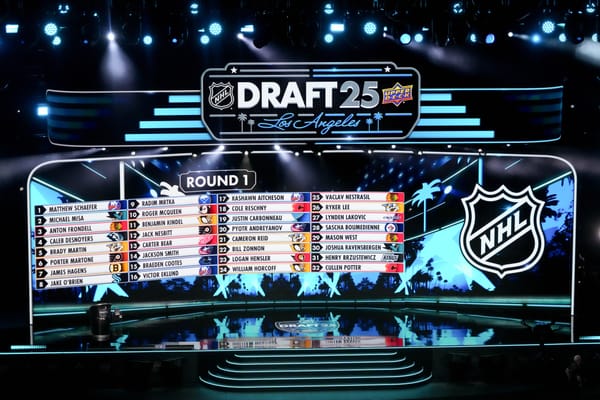An Analytical Look At Rangers’ 2017-18 Forward Deployment
Forwards are tasked with different roles throughout a lineup – roles that vary based on the ice time they see, where and when they’re deployed and their overall production expectations. Some lines face more challenging starts in the defensive zone and others are sheltered with more offensive zone starts. Certain players play the most minutes, in the most crucial moments, and are expected to be a consistent source of offense. Others emulate a defensive style and aren’t expected to contribute as much on the scoresheet.
Sean Tierney (@ChartingHockey) has put together player charts that are updated daily throughout the 2017-18 season, using data from Corsica.hockey. One of those charts classifies whether a player is unproductive, productive, underused and overused based on their time on ice percentage (TOI%) and points per 60 minutes (P60) at 5-on-5.
This chart gives insights into the player usage of the New York Rangers, as it depicts which players are producing based on their ice time. It gives a surface-level indication into who has merited a greater opportunity and whose roles should be minimized, and can serve as a starting point for further analysis.
By a narrow margin (less than one tenth of a point), Jesper Fast falls into the underproductive classification. This makes sense based on his role though; Fast is quietly effective in his role that focuses on defense rather than overwhelming offense. His placement on this chart makes sense when considering his point production, he’s only scored at a rate of 1.56 per hour in 192.23 5-on-5 minutes.
For a bottom-six player like Fast, this performance isn’t concerning, although the decision to move a player like him to the second line is questionable. Then again, in the one game he’s played in that role this season, he did collect an assist. However, it doesn’t mean it’s a role he’s necessarily suited for when considering the expectations for a second-line winger on a team that craves 5-on-5 offense.
Rick Nash, Kevin Hayes, Mika Zibanejad, and J.T. Miller find themselves in the productive quadrant. Zibanejad has thrived this year after being promoted as the team’s first-line center and has been a reliable source of offense. He leads the team with 20 points in all situations, eight of which have been scored at 5-on-5.
Hayes is second on offense with a 29.08 TOI% and has scored at the third highest rate (1.91 points per hour). Yet again, this season he’s starting many of his shifts in the defensive zone (32.97 percent) and fewer in the offensive zone (28.26 percent, second lowest on offense). Still, he has a positive relative Corsi for percentage (plus-1.19) and relative expected goals for percentage (plus-8.15) because of his strong two-way play, showing just how effective he’s been on both sides of the ice.
Nash has moved into the productive quadrant after a slow start to the season, where he only had one point in his first 11 games. He’s made up for it with 10 all-situation points in his last 10 games. All together, he’s accumulating 1.66 points per hour, and that just qualifies him in the productive quadrant. Nash’s efforts on both sides of the ice shouldn’t go unnoticed, even when he doesn’t have the tangible results to quantify it. While he may not be able to score at the rate that he has in these past 10 games, he hopefully can maintain his productive classification moving forward.
The player in the productive quadrant that stands out the most is Miller. It’s not that he isn’t productive, because he has scored eight points at 5-on-5 this season (although both Zibanejad and Buchnevich have matched those points in less ice time). Unlike Zibanejad and Buchnevich, Miller’s possession numbers haven’t been favorable this year; his play in his own zone has been dragging down those numbers.
Miller’s been on the ice for 61.96 shot attempts against per hour minutes, which is the highest of the forwards (and third highest on the entire team). Plus, his expected goals against per 60 of 3.48 is the second highest of the forwards. These numbers are even more concerning when factoring in his zone starts; he leads the team with the highest percentage of offensive zone starts (39.31 percent); so as productive as Miller has been in the offensive zone, his play in his own zone has to change – whether that entails a change in tactics or linemates.
Mats Zuccarello, Chris Kreider, and Jimmy Vesey fall into the overused quadrant. Zuccarello has seven 5-on-5 points (29.06 TOI%), Kreider has four (26.35 TOI%), and Vesey has five (26.5 TOI%). Kreider and Zuccarello have had a positive influence on the team’s offense generation – Kreider has a plus-2.77 relative CF% and plus-4.76 relative xGF%, while Zuccarello has a plus-0.61 relative CF% and a plus-1.81 xGF%. Vesey on the other hand, falls below the team average with a minus-3.36 relative CF% and minus-3.33 relative xGF%. However, Vesey has been challenged with a high number of defensive zone starts (34.98 percent), while Kreider and Zuccarello start in the offensive zone more often, and those starts can influence a player’s possession numbers.
Vesey’s ice time still has been somewhat questionable as he’s a middle-six forward that’s been given more opportunities than some higher-caliber players, like Nash and Buchnevich, and hasn’t had the production to match that – which could be why he was demoted to the fourth-line on Sunday.
Zuccarello added two more points on Sunday to improve his scoring rate and moved closer to the productive quadrant. Still, neither Zuccarello or Kreider’s 5-on-5 scoring has matched their ice time, which is why they’re still falling below the productive classification. Nevertheless, they’ve been influential on the Rangers’ offensive generation; if they can continue playing in that way, they should find more tangible results.
Lastly, there are three players that can be considered underused when looking at their production and their ice time percentage – Michael Grabner, David Desharnais, and Pavel Buchnevich.
Grabner and Desharnais have both scored seven 5-on-5 points. On the surface, giving either of them a greater share of ice time can make sense based on their scoring rates, but neither really should have an expanded role. They’re bottom-six forwards that have capitalized on opportunities, but don’t provide more than secondary scoring.
Grabner is a bottom-six winger, a good one at that, but shouldn’t move higher in the lineup (no, not even after last season’s 40-point fluke). There’s nothing wrong with that though; he fulfills his role quite well and if he continues to produce at this rate he’ll rightfully remain in the underused quadrant.
As for Desharnais, his ice time in recent games has dwindled, particularly in the third period, and was a healthy scratch on Sunday – so with that in mind, underused is somewhat fitting. On the other hand, it doesn’t mean he should have a role anywhere other than the bottom-six, even when factoring in his scoring. He’s a minus-6.71 relative to his teammates’ CF% and his relative xGF% is minus-11.2, despite starting in the offensive zone 35.51 percentage of the time and defensive zone only 28.97 percent of the time.
The one underused player that’s truly underused and has merited an expanded role is Buchnevich. Buchnevich has eight 5-on-5 points that he’s scored at the second highest rate of 2.11 per hour. He also leads the team with a 2.62 game score per 60, a plus-13.99 relative xGF%, and has the third-highest relative CF% of plus-6.16 on the team (trailing Zibanejad and Tony DeAngelo). His individual Corsi for per 60 of 17.39 is the second highest on the team, while is individual expected goals for per 60 of 0.96 is the third highest on the team.
Somehow, Buchnevich was demoted from the first line to the fourth line earlier this season. He returned to the first line against the Vegas Golden Knights and remained there as the Rangers went on a six-game winning streak. But his 5-on-5 ice time, regardless of which line he’s played on, still hasn’t been particularly high (23.35 TOI%). Against the Columbus Blue Jackets last Friday, when the lines were shuffled to generate offense, Buchnevich was demoted to the third line – even though it’s his offensive production that helped the Rangers turn their season around on that win streak.
Boo Nieves and Paul Carey’s TOI% aren’t high enough to fit onto this chart, but it’s still worth noting that in the eight games Nieves has played, his production has been solid (2.36 points per hour, plus-4.64 relative CF%, and plus-9.56 relative xGF%). It’s not clear if he can maintain that with more ice time, but it’s an encouraging sample that could warrant more ice time. Carey’s play in nine games hasn’t been too impactful (zero points, plus-3.95 relative CF%, minus-6.87 relative xGF%), but again, it’s a small sample. Still, it’s a sample that could inspire a call up for a more influential forward.
The Rangers 5-on-5 production still needs to improve. Their power play has been a strength and given them an advantage, but that requires them to draw penalties, which isn’t always guaranteed in a game. While a stellar power play gives them an edge, their 5-on-5 play still has to be the priority. A step in improving that is utilizing players accordingly based on their production.
Scoring is a priority to most coaches, so it’s usually an indicator of the ice time a player will receive. It’s a surface-level look that is usually the first step in analysis, but each player’s production should be further examined to see how players are performing on both sides of the ice, even when the puck isn’t going in the net. That way, the players that are consistently playing in a way that generates offensive opportunities receive the ice time they deserve.
Appropriately utilizing their forward group would help the Rangers gain a 5-on-5 edge that they’ve been missing this season, and help them find more sustainable success even when the whistles aren’t going their way.
*All data is at 5v5, via Corsica.hockey




